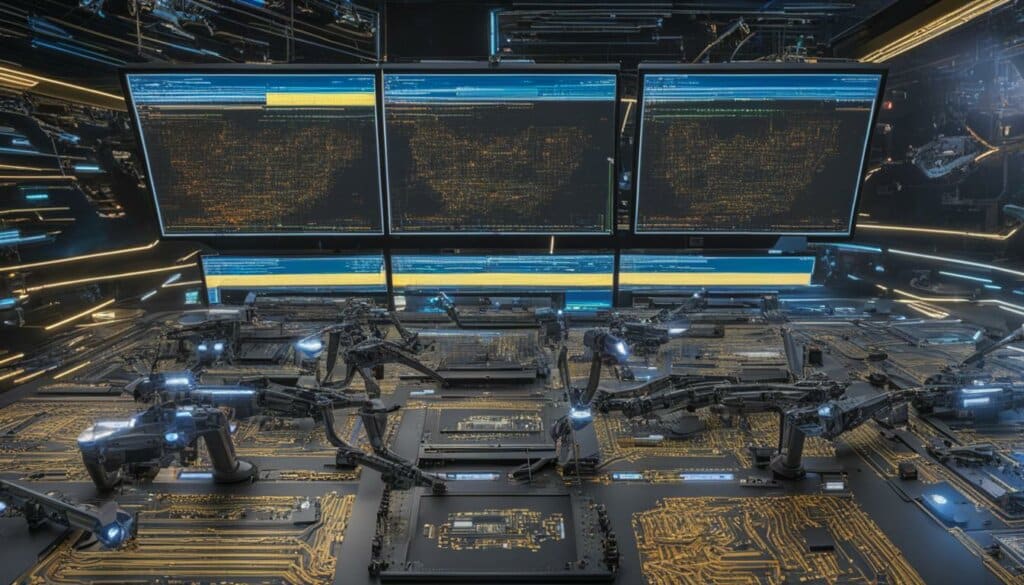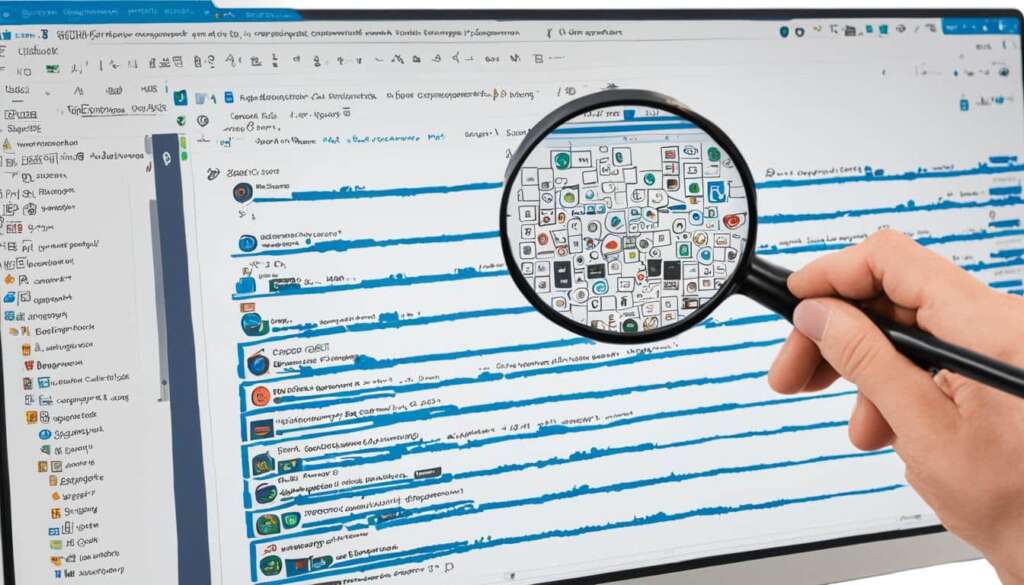Table of Contents
Are you wondering if a text you’ve come across was generated by ChatGPT? Detecting the usage of ChatGPT can be challenging, but there are techniques and methods that can help you determine whether a text is AI-generated or human-written.
From emails and cover letters to marketing pitches and college essays, ChatGPT is being implemented in various contexts. It’s important for educators, job recruiters, and content publishers to be able to identify chatGPT usage to ensure the integrity and authenticity of the content they encounter.
AI detectors are valuable tools in detecting ChatGPT usage. These detectors analyze the writing style, structure, grammar, vocabulary, and other factors to provide insights into whether a text is likely AI-generated. In this article, we will explore some popular AI detectors and discuss their effectiveness in identifying ChatGPT usage.
Before we delve into the specific AI detectors, it’s important to note that both ChatGPT and AI detectors have their limitations. While AI detectors can be helpful, they may not always provide accurate results. Therefore, it is crucial to combine human assessment with AI detectors in order to make informed conclusions about the origin of a text.
In the following sections, we will explore the popular AI detectors available for detecting ChatGPT usage, provide examples and tips on how to identify AI-generated text, discuss the results of AI detectors on ChatGPT-written text, and highlight the importance of detecting ChatGPT usage in various domains.
Stay tuned to learn more about effective techniques to determine ChatGPT usage and discover how you can ensure the integrity and authenticity of the content you encounter.
Popular AI Detectors for ChatGPT Usage
When it comes to detecting ChatGPT usage, several AI detectors have emerged to assist in this process. These detectors analyze various aspects of the text, such as writing style, grammar, vocabulary, and structure, to determine whether it is AI-generated or human-written. Here are some popular AI detectors that can help identify the usage of ChatGPT:
- AI Text Classifier from OpenAI: This tool grades the text based on the likelihood of it being AI-generated. It utilizes advanced algorithms to analyze multiple linguistic features and provide an evaluation.
- GPTZero: Developed by a college student, GPTZero focuses on assessing text complexity and sentence structure to determine if it has been generated by an AI model like ChatGPT. It uses sophisticated linguistic analysis to differentiate between AI-generated and human-written content.
- Originality.AI: With a strong focus on business-oriented content, Originality.AI specializes in detecting plagiarism and AI-written material. It employs advanced algorithms to compare text with a vast database of known AI-generated content and identify potential matches.
- Writer AI Content Detector: Developed by Writer.com, this detector is designed to identify AI-generated content and assign it a detection score. It utilizes cutting-edge natural language processing techniques to analyze and evaluate text for AI characteristics.
- ZeroGPT: ZeroGPT is a free AI detector that employs a proprietary technology called DeepAnalyse to detect AI-generated text. It applies advanced linguistic analysis and machine learning algorithms to assess the text for AI-driven patterns and characteristics.
These AI detectors play a vital role in identifying the usage of ChatGPT and other AI models. They provide valuable assistance to educators, job recruiters, and content publishers who want to ensure content integrity and verify the authenticity of the text.
| AI Detector | Detection Method | Main Features |
|---|---|---|
| AI Text Classifier from OpenAI | Analysis of linguistic features | Grading based on likelihood of AI generation |
| GPTZero | Assessment of text complexity and sentence structure | Differentiation between AI-generated and human-written content |
| Originality.AI | Plagiarism and AI-generated content detection | Comparison with known AI-generated content |
| Writer AI Content Detector | Advanced natural language processing techniques | Identification and scoring of AI-generated content |
| ZeroGPT | Proprietary deep linguistic analysis | Detection of AI-driven patterns and characteristics |
Detecting ChatGPT Writing: Examples and Tips
To better understand how to detect ChatGPT writing, let’s examine some examples. AI-generated text often exhibits overly complex sentence structures, formal tone, and unusual or incorrect wording. Rambling and repetitive sentences, as well as vague statements without providing much information, are also common in AI-written content. Unnecessarily long and wordy articles can be another red flag. Paying attention to these indicators can help in identifying text that may have been generated by ChatGPT or similar AI models.
“The emergence of artificial intelligence has revolutionized various industries, including healthcare, finance, and transportation. With its ability to process vast amounts of data and perform complex tasks, AI has become indispensable in today’s fast-paced world.”
Notice the formal tone and complex sentence structure in the example above. The content lacks specific details, providing a vague, generalized statement. These characteristics are common in AI-generated text.
Red Flags in AI-generated Text:
- Overly complex sentence structures
- Formal tone
- Unusual or incorrect wording
- Rambling and repetitive sentences
- Vague statements without providing much information
- Unnecessarily long and wordy articles
Identifying these red flags can help distinguish between AI-generated and human-written content.
Examples of AI-generated Text:
| AI-generated Text | Human-written Text |
|---|---|
| “The advancements in technology have significantly impacted our lives, enabling seamless communication and access to information.” | “Technology has revolutionized how we communicate and access information, making our lives more convenient.” |
| “The exponential growth of artificial intelligence has paved the way for unprecedented advancements in various sectors.” | “Artificial intelligence has led to remarkable progress in multiple industries due to its rapid growth.” |
| “As a passionate writer and technology enthusiast, I am thrilled to explore the endless potentials of AI.” | “My passion for writing combined with a strong interest in technology motivates me to explore the vast possibilities of AI.” |
In the examples above, the AI-generated text tends to have a formal tone, complex sentence structures, and lacks the natural flow present in the human-written text.
By being aware of these examples and red flags, readers and content creators can better identify AI-generated content and differentiate it from human-written content.

Testing AI Detectors on ChatGPT-Written Text
We carried out rigorous tests using various AI detectors to evaluate their accuracy in detecting ChatGPT-written text. These detectors play a crucial role in distinguishing between AI-generated and human-written content, and their performance can greatly impact the reliability of detecting ChatGPT usage.
Results of the Testing
During our assessment, we employed three popular AI detectors: the AI Text Classifier from OpenAI, GPTZero, and Writer AI Content Detector. The aim was to gauge their effectiveness in identifying ChatGPT usage.
Firstly, the AI Text Classifier from OpenAI provided reliable results. It correctly identified the ChatGPT-written text as highly likely to be AI-generated, showcasing its proficiency in detecting AI-written content.
The AI Text Classifier demonstrated remarkable accuracy, effectively identifying the unique signatures of ChatGPT-generated text.
However, GPTZero, an AI detector developed by a college student, surprisingly perceived the same ChatGPT-written text as human-written. This discrepancy emphasizes the variability in performance among different AI detectors and highlights the challenges in accurately detecting AI-generated content.
On the other hand, Writer AI Content Detector accurately graded the ChatGPT-written text as 0% human-generated content. This detector’s advanced algorithms and robust analysis capabilities proved successful in distinguishing between AI-generated and human-written text.
Comparative Analysis
To provide a comprehensive overview of the results, we present the performance of the tested AI detectors in the following table:
| AI Detectors | AI-Generated Text Detection |
|---|---|
| AI Text Classifier from OpenAI | Highly accurate – detected ChatGPT-written text as AI-generated |
| GPTZero | Identified ChatGPT-written text as human-written |
| Writer AI Content Detector | Accurately graded ChatGPT-written text as 0% human-generated content |
These findings underline the varying performance of AI detectors in detecting ChatGPT usage and further emphasize the necessity of robust testing to achieve accurate results.
To optimize the accuracy in detecting ChatGPT usage, it is vital to understand the limitations of each AI detector and be aware of their potential biases. Employing a combination of different AI detectors and human assessment remains the most reliable approach to ensure the integrity of content and identify AI-generated text effectively.
Can ChatGPT Writing be Detected?
While AI detectors can be useful in detecting ChatGPT writing, it is important to acknowledge their limitations. ChatGPT and similar AI models are constantly evolving, making it challenging for detectors to keep up with the changes. AI detectors may mislabel both AI-generated and human-written text and can be less accurate on text written by children or in languages other than English. Additionally, AI detectors may not be able to detect AI-generated content that has been modified to appear more human-like. Humans still play a crucial role in detecting AI-written content and should exercise caution when relying solely on AI detectors.
“AI detectors may mislabel both AI-generated and human-written text and can be less accurate on text written by children or in languages other than English.”
As AI technology advances, the challenges in detecting AI-generated text become more complex. AI detectors rely on patterns and data analysis to make determinations, but the rapid evolution of AI models presents obstacles for accurate detection. These detectors may struggle to discern between AI-generated and human-written content, leading to potential misclassifications.
Limitations of AI Detectors
One of the main limitations of AI detectors is their dependence on historical data to recognize patterns. They learn from past instances of AI-generated text and apply that knowledge to identify similar patterns in new texts. However, ChatGPT’s ability to generate text that mimics human writing style and structure poses a challenge for AI detectors that rely heavily on pattern recognition.
Another limitation arises when AI detectors encounter text written by children or in languages other than English. These texts may exhibit different linguistic patterns and structures, making it more difficult for detectors to accurately identify AI-generated content.
Challenges in Detecting AI-Generated Text
The primary challenge in detecting AI-generated text lies in the constant advancements and refinements made to AI models like ChatGPT. As these models improve, their ability to generate highly realistic human-like text increases, making it even harder for AI detectors to distinguish between AI-generated and human-written content.
Furthermore, adversarial attacks can be employed to modify AI-generated text and make it appear more human-like. These subtle modifications may go undetected by AI detectors that rely on specific patterns and features to identify AI-generated content.
| Challenges | Solutions |
|---|---|
| Marked limitations in recognizing AI-generated text | Focus on continuous development and improvement of AI detectors |
| Difficulties in identifying AI-generated content written by children or in languages other than English | Incorporate diverse language models and linguistic patterns in AI detectors |
| The evolution of AI models and their ability to mimic human-like text | Advance AI detectors to recognize subtle differences between AI-generated and human-written content |
| Adversarial attacks modifying AI-generated text | Implement robust detection methods to identify modified AI-generated content |
Despite these challenges, the continued collaboration between AI detectors and human evaluators can enhance the detection process and mitigate the risks associated with AI-generated content.
By combining the capabilities of AI detectors with human judgement, the detection of ChatGPT writing can be more accurate and reliable. Humans can provide contextual analysis, critical thinking, and a deeper understanding of the nuances in written content. This collaborative approach ensures a more comprehensive and effective detection process.
The Importance of ChatGPT Detection
Detecting ChatGPT usage is of paramount importance across various domains. By identifying AI-generated content, we can ensure the integrity and authenticity of the information we encounter.
In Education
One crucial application of detecting AI-generated content is in education. By accurately detecting ChatGPT usage, we can verify that students rely on their own skills and knowledge to complete assignments and exams, fostering academic integrity and fair evaluation.
In Information Security
Detecting AI-written content plays a vital role in information security. It allows us to thwart attempts at deception and impersonation, safeguarding sensitive data and preventing malicious actors from manipulating content for their ulterior motives.
Within Journalism and Media
In the realm of journalism and media, detecting AI-generated content holds immense significance. It enables us to fact-check and verify information, ensuring the accuracy and reliability of news stories. By uncovering AI-generated articles, we can enhance transparency and integrity in the field.
Maintaining Content Integrity and Preventing Deception
By effectively detecting ChatGPT usage, we can maintain content integrity and prevent the spread of misinformation. The ability to differentiate between AI-written and human-generated content allows us to preserve the trust of readers and consumers, safeguarding their interests and ensuring they receive accurate and reliable information.
“Detecting ChatGPT usage is not just about uncovering AI-generated content; it is about upholding transparency, authenticity, and truth in today’s digital age.”
By investing in robust detection mechanisms and combining human assessment with AI detectors, we can effectively navigate the challenges posed by AI-written content, preserving the veracity and credibility of the information we consume and share.
Conclusion
Detecting ChatGPT usage is a complex task, but with the help of AI detectors, it is possible to identify AI-generated text. Various tools, such as the AI Text Classifier, GPTZero, and Writer AI Content Detector, can assist in detecting ChatGPT usage. These detectors analyze writing style, structure, grammar, and vocabulary to determine if a text is likely AI-generated or human-written.
However, it is important to remember that both ChatGPT and AI detectors have limitations. ChatGPT and other AI models are constantly evolving, making it challenging for detectors to keep up with changes. AI detectors may also mislabel text or be less accurate in certain contexts, such as text written by children or in languages other than English.
While AI detectors are valuable tools, humans still play a significant role in detecting AI-written content. By combining human assessment with AI detectors, users can ensure the integrity and authenticity of the content they encounter. This collaborative approach is crucial in domains such as education, information security, journalism, and media to prevent deception, preserve content integrity, and maintain reader trust.
FAQ
How can I check if ChatGPT was used in a text?
There are AI detectors available that analyze the writing style, structure, grammar, vocabulary, and other factors to determine if a text is likely AI-generated or human-written.
What are some popular AI detectors for detecting ChatGPT usage?
Some popular AI detectors include the AI Text Classifier from OpenAI, GPTZero, Originality.AI, Writer AI Content Detector, and ZeroGPT.
How can I identify ChatGPT writing?
AI-generated text often exhibits complex sentence structures, formal tone, unusual wording, and vague statements. Paying attention to these indicators can help identify ChatGPT writing.
Are there any examples of AI-generated text that can help in detecting ChatGPT usage?
AI-generated text may consist of overly complex and repetitive sentences, as well as unnecessarily long and wordy articles. These examples can serve as red flags in identifying AI-written content.
Have AI detectors been tested on ChatGPT-written text?
Yes, AI detectors such as the AI Text Classifier, GPTZero, and Writer AI Content Detector have been tested on ChatGPT-written text to evaluate their accuracy in detecting AI-generated content.
Can ChatGPT writing be easily detected using AI detectors?
While AI detectors can assist in detecting ChatGPT writing, they have limitations and may mislabel both AI-generated and human-written text. Humans still play a significant role in identifying AI-written content.
Why is detecting ChatGPT usage important?
Detecting ChatGPT usage is important in maintaining content integrity, preventing the spread of misinformation, and preserving the trust of readers and consumers.
What are some final thoughts on identifying AI-generated content?
It is essential to combine human assessment with AI detectors to ensure the authenticity and integrity of the content encountered.













